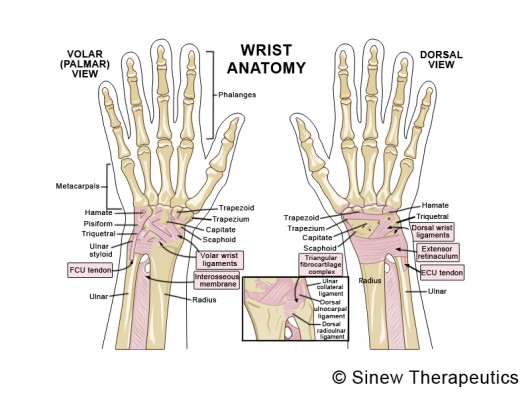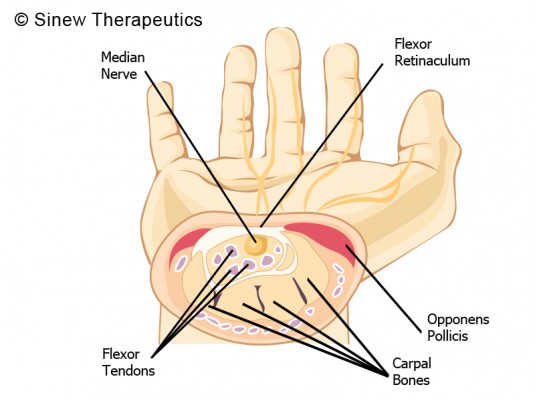Of orthopedic injuries, sprains and strains are among the most common. While wrist sprains involve an injury to the ligament, wrist strains involve injury to the muscle. Both injuries are very common among athletes and those at a high risk of falling.



Wrist Sprain / Strain
The wrist is made up of eight carpal bones: the lunate, capitate, triquetrum, scaphoid, pisiform, trapezium, trapezoid, and hamate. It’s also comprised of the radius and ulna forearm bones. There’re multiple ligaments connecting the bones to each other.
What Causes Wrist Sprain?
Falls account for a large percentage of wrist sprains. As the person becomes unbalanced or slips, they usually inevitably stick their hand out to break the fall or try to catch hold of something. When the hand strikes the ground or nearby object under the force of the fall, it bends the hand back toward the forearm. This action can stretch the ligaments connecting the wrist and bones of the hand beyond the normal range of motion and possibly cause tearing or breaking of the ligament. Being hit in the wrist, applying extraordinary pressure to it, or twisting it can also cause a wrist sprain.
Grades of Wrist Sprains
Grade 1 - minor damage to the ligament or microscopic tears with pain.
Grade 2 - more severe ligament damage or partial ligament tearing that causes pain, looseness in the joint, and mild loss of function.
Grade 3 - the ligament is completely torn and results in severe looseness in the joint and severe loss of function.
The symptoms of Wrist Sprain include bruising, pain, swelling, warmth, tenderness and a popping or painful stretching sensation in the wrist area.
What Causes Wrist Strains?
A wrist strain is an injury to the muscles and/or tendons of the wrist. The bones at the wrist and soft tissue, including nerves and blood vessels, around the wrist may also be involved in the injury. This injury is usually caused by a blunt force injury, extraordinary pressure or stress, or long-time overuse of the muscles and tendons in the wrist or forearm.
Grades of Wrist Strains
Grade 1 - slightly pulled muscle with no muscle or tendon tearing and no loss of strength.
Grade 2 - tearing of muscle or tendon fibers with some diminished strength.
Grade 3 - rupture of the muscle or tendon with separation of fibers.
The symptoms of Wrist Strain include redness, swelling, pain upon stretching or movement of wrist, forearm muscle spasms, loss of wrist strength and crackling sound or feeling when the area has pressure applied to it.
Strengthening Exercises
These Wrist Exercises are ideal to build strength and flexibility.
Massage Treatment
These Wrist Massage Techniques are of great value in pain relief; circulation stimulation; dispersing blood and fluid accumulations; swelling reduction; and relaxing muscle spasms, especially when used alongside the Sinew Therapeutics liniments and soaks.
ACUTE STAGE SYMPTOMS AND TREATMENT
This stage is characterized by swelling, redness, pain, and possibly a local sensation of heat, indicating inflammation. If coolness makes your pain feel better, then the Acute Stage Treatment is recommended.
ACUTE STAGE SYMPTOMS:
The acute stage starts the moment an injury occurs and lasts until the swelling and inflammation are gone. The swelling is the result of the blockage of blood, tissue fluids and circulation in the wrist because their normal movement has been disrupted by the force of the injury. Just like cars back up behind a traffic jam, causing congestion, exhaust and overheating; blood and fluids back up behind the injured wrist, causing pain, inflammation, lumps and swelling.
The sensation of heat is due to the warming action of the blood and fluids overheating in the injured wrist as they back up and accumulate. Stiffness and decreased mobility are due to spasms in tendons and ligaments that have contracted reflexively beyond their normal range from the impact of the injury.
As ligaments and tendons stretch and tear, blood from ruptured blood vessels becomes trapped in the local tissues. As the trapped blood clots up, it sticks the tissues together creating adhesions. Adhesions cause pain, inflammation and restricted movement because the layers of tissue that used to slide smoothly across one another now adhere and snap which interferes with normal functioning. It is essential to break up clotted blood as quickly as possible to prevent adhesions and scar tissue from forming.
During the acute stage it is very important to restore normal circulation to the wrist, break up clotted blood and stagnant fluids, reduce swelling, and reduce the redness and heat associated with inflammation. By restoring the flow of blood, fluids, and circulation in the wrist, then pain is relieved, damaged tissues can regenerate with healthy functional tissue, and the wrist can strengthen and regain it's mobility.
ACUTE STAGE TREATMENT:
1. Apply the Sinew Herbal Ice on your wrist to reduce redness, swelling, and inflammation while dispersing accumulated blood and fluids to help restore normal circulation to the wrist. This first-aid treatment is used in place of ice to significantly speed up the healing process. It reduces the swelling and inflammation more effectively than ice, allowing you to more quickly regain range of motion. Acute Sinew Liniment can be used in-between applications.
Ice is not recommended because it does not help repair damaged tissues and keeps everything in the injured area frozen, causing the stagnation of blood and fluids and the contraction of muscles, tendons and ligaments. In Chinese sports medicine ice is not used and is considered a culprit in injuries that donít heal well.
2. Massage your wrist with Acute Sinew Liniment to relieve pain, reduce swelling and inflammation, break up clotted blood and stagnant fluids, and stimulate circulation of blood and fluids to help cells quickly repair damaged tissues. Sinew Herbal Ice can be used in-between applications.
3. The Sinew Sports Massage Oil is recommended for use before and after exercise, sports and strenuous activity. It warms and stimulates your muscles, increases circulation and relieves tightness, hence improving your performance and helping to prevent injury.
CHRONIC STAGE SYMPTOMS AND TREATMENT
This stage begins once the swelling and inflammation are gone, but you still feel pain, stiffness, weakness, and/or sensitivity in cold and damp weather. If heat makes your pain feel better, then the Chronic Stage Treatment is recommended.
CHRONIC STAGE SYMPTOMS:
The chronic stage begins once the swelling and inflammation are gone, but you still feel aching pain and stiffness. This is because there are still accumulations of stagnant blood and fluids in your wrist that are blocking circulation and blood supply to damaged tissues, creating residual pain, stiffness and weakness. You may actually feel hard nodules like sand in the tissue, indicating accumulation, calcification, and adhesions, which all cause pain, stiffness, and joint instability.
Your wrist may feel more sensitive to the cold and ache in cold and damp weather due to impaired circulation. When you move your wrist you may hear a clicking or popping sound from the tendons and ligaments slipping very slightly in and out of their natural alignment indicating weakness and joint instability, causing chronic pain and a cycle of reinjury. These symptoms are often the result of failure to treat the injury properly from the outset and overicing.
Increasing circulation and blood supply to the damaged tissues is very important in treating chronic injuries because tendons and ligaments do not have an extensive direct supply of blood. That is why chronic injuries can be slow to heal. Increasing local circulation also prevents cold and dampness from penetrating the injured area, preventing pain and stiffness.
During the chronic stage it is very important to break up remaining accumulations of blood and fluids, and increase circulation and blood supply to the damaged tissues. By increasing circulation and blood flow in the wrist, then pain and stiffness is relieved, and the tendons and ligaments can strengthen to restore stability.
CHRONIC STAGE TREATMENT:
1. Massage your wrist with Chronic Sinew Liniment to relieve pain and stiffness, strongly stimulate circulation and blood flow to damaged tissues, and promote the healing of overstretched tendons and ligaments. The Sinew Relaxing Soak can be used in-between applications.
2. Soak your wrist with the Sinew Relaxing Soak to relax muscles and tendons that are in spasm, ease joint pain and stiffness, and improve range of motion. The Sinew Relaxing Soak is particularly useful if you feel restricted mobility in your wrist. Chronic Sinew Liniment can be used in-between applications.
3. The Sinew Sports Massage Oil is recommended for use before and after exercise, sports and strenuous activity. It warms and stimulates your muscles, increases circulation and relieves tightness, hence improving your performance and helping to prevent injury.








